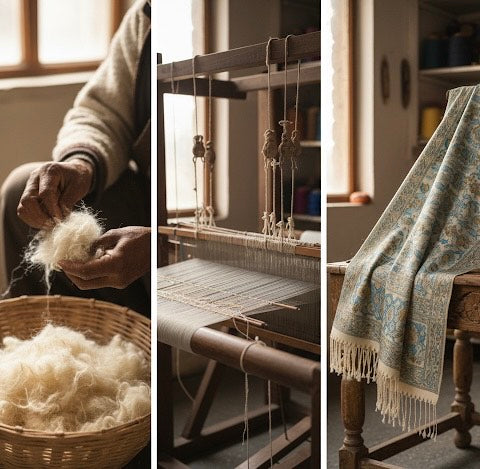
The Timeless Art of Pashmina: A Legacy of Kashmir
Pashmina, a word that instantly evokes luxury, warmth, and timeless beauty. Known as the “soft gold” of Kashmir, Pashmina shawls have adorned royalty, celebrities, and art connoisseurs for centuries. But what makes Pashmina so special, so rare, and so coveted across the world?
Let’s explore the fascinating story behind this exquisite craft.
What is Pashmina?
Pashmina comes from the Persian word “Pashm”, meaning “soft gold” or “fine wool.” It is hand-spun from the delicate undercoat of the Himalayan Changthangi goat, found in the high-altitude regions of Ladakh.
The fine fibers, six times thinner than human hair are meticulously handwoven by skilled Kashmiri artisans into luxurious shawls, scarves, and wraps. Each piece takes months to complete, embodying patience, artistry, and tradition.
Types of Pashmina Shawls
Kashmiri craftsmanship has evolved over centuries, giving rise to different styles of Pashmina shawls, each with its own identity and artistic heritage:
1. Kani Pashmina
A masterpiece of weaving, Kani shawls are created using small wooden sticks called kanis instead of needles. The designs are woven thread by thread not embroidered, forming intricate floral and paisley patterns. It can take over a year to complete one Kani shawl, making it a true collector’s item.
2. Jamawar Pashmina
Derived from the Persian “Jam-e-waar” (a robe of glory), Jamawar shawls feature intricate woven or embroidered motifs inspired by Mughal artistry. They are often adorned with elaborate paisleys, vines, and floral designs, symbolizing nobility and grace.
3. Kalamkari Pashmina
Kalamkari means “art done with a pen.” These shawls are hand-painted or hand-embroidered with natural dyes, telling stories of nature, mythology, and culture. Each piece is a living canvas of art.
4. Sozni Embroidered Pashmina
Sozni is delicate needle embroidery done by hand, often along the borders or covering the entire shawl. The intricate stitches bring out patterns of chinar leaves, flowers, and vines, all done with unmatched precision.
How is a Pashmina Made?
The making of a Pashmina is an elaborate journey of love and skill:
-
Collection: The fine wool is collected by combing the Changthangi goat during spring molting.
-
Spinning: The wool is hand-spun into yarn using a traditional spinning wheel (yender).
-
Weaving: Skilled artisans hand-weave the yarn on wooden looms into shawls.
-
Dyeing & Embroidery: The shawl is naturally dyed and then embroidered, painted, or patterned according to design.
Every stage is entirely manual, no machines, only hands guided by generations of mastery.
Why Are Pashmina Shawls So Expensive?
A genuine Pashmina is rare and takes months, sometimes a full year to craft. The reasons behind its high value include:
-
Rarity of Raw Material: The fine Pashmina fiber is sourced only from Himalayan goats.
-
Labor-Intensive Craftsmanship: Each shawl is hand-spun, handwoven, and hand-embroidered.
-
Time: A single shawl can take anywhere from 3 months to a year to complete.
-
Purity: Authentic Pashmina contains no synthetic blend only 100% natural fiber.
Owning one is not just a purchase, it’s owning a piece of heritage.
Who Wears Pashmina?
Throughout history, Pashmina has graced the shoulders of royalty, poets, and icons.
From Empress Josephine Bonaparte of France, who famously owned over 400 Kashmiri shawls, to Queen Victoria, Maharajas of India, and modern-day celebrities like Kate Middleton, Angelina Jolie, and Priyanka Chopra, Pashmina continues to symbolize grace and luxury across generations.
The Legacy Continues with NAAZ
At NAAZ, our founder Shahid Malik, originally from the beautiful valleys of Kashmir and now based in Toronto, had a vision to bring the timeless art of Kashmiri craftsmanship and the unmatched elegance of luxury Pashmina shawls to the global stage.
Inspired by his roots and driven by a deep passion for preserving heritage, Shahid founded NAAZ to showcase the authenticity, warmth, and artistry of Kashmiri Pashmina, a treasure that deserves worldwide recognition. Today, NAAZ stands as a bridge between Kashmir’s centuries-old handloom traditions and modern global luxury, making every piece a story of culture, care, and craftsmanship
